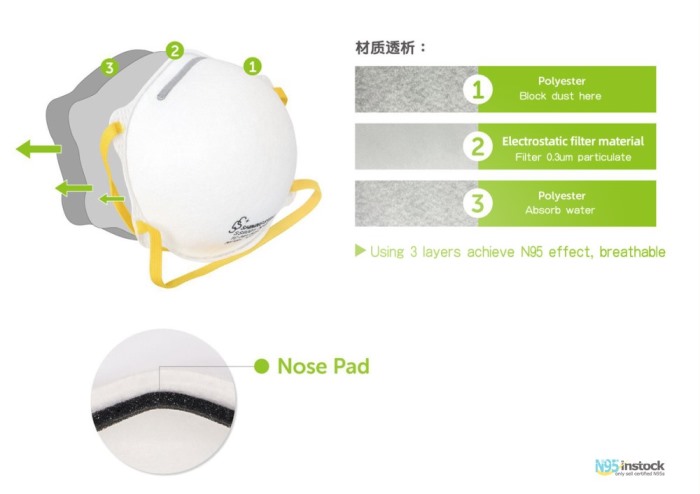Sawing wood is a laborious task! It is crucial to always take care of your skin so that you can do your ideal work every day. Therefore, these five face masks are suitable for use when cutting wood, particularly if you have sensitive skin that is easily affected by sawdust, take a look N95 medical respirator. The following are our recommendations. The Dangers of Wood Dust Inhalation
Breathing in wood dust can result in bronchial asthma and other breathing issues, such as nosebleeds and allergic responses; allergies; breathing difficulties; chronic obstructive pulmonary disease (COPD); and lung cancer cells in woodworkers, just see china N95 respiratory masks supplier. Individuals exposed to wood dust may develop skin irritation, itching, and rashes. The impact of wood dirt from various tree species on human health vary. Wooden products are the most hazardous since they contain more hazardous compounds and have smaller particles, resulting in finer dust. When treated or machined with high-speed tools that produce larger bits than conventional hand tools or fining sand processes, certain softwood materials might pose equivalent risks. When sawing, must a mask be worn? With all of these little fragments flying around, it’s quite simple to get hurt. As recommended by OSHA, wearing a mask or respirator will keep sawdust out of your nose and mouth while also protecting your face from splinters. Using a low-cost dust mask or non-reusable breathing cover is preferable to doing nothing. While you are not required to purchase an industrial-strength respiratory system protection device built expressly for woodworking (they range from $30 to $200), doing so is better to doing nothing. Normal turban masks are also permitted so long as they cover the nose and mouth entirely. Is the N95 respirator effective against sawdust? Some individuals use the older, traditional 3M 8210 respirator for simple wood sanding. A number of people would describe this look as a dirt mask. Others would likely assert that it is not significantly superior than nose hair. It is a N95, meaning it will filter out 95% of particulate matter, which is far better than nothing. What is the best mask for woodworking? Four types of face masks are distinguished: disposable, dust-filtering, allergic reaction, and HEPA. Non reusable masks are price friendly and offer some sawdust protection. They are best suited for situations with minimum dirt exposure and are not reusable (such as tidying up a little spill). Dust-filtering masks are slightly more expensive than disposable masks, but they offer superior protection against larger particles, and some of them also incorporate exhalation valves to make breathing easier. Because they fit easily over your glasses or safety goggles, they are suitable for situations with limited space. Here are some exceptional face masks for basic woodworking. NIOSH-Approved Harley L-288 N95 Respirator Mask
The National Institute for Occupational Safety and Health has actually certified the Harley L-288 as a N95 respirator (NIOSH). As an NIOSH-approved mask, the L-288 has passed rigorous infiltration, breathing resistance, and strap tensile strength tests. The Harley N95 Respirator eliminates as much contamination as is possible. NIOSH-Approved Shining Star SS9001-N95 Face Mask
Radiating Star’s SS9001-N95 Mask has just just gotten the NIOSH permission, making it one of minority masks allowed by both NIOSH and also the Occupational Safety and also Health Administration (OSHA) (OSHA). This one-of-a-kind mask protects against airborne harmful germs, making it a useful tool for anybody who may come into direct touch with such microbes, including construction workers, food trainers, and cleaning personnel. It is important to understand why you should use this mask and how it differs from others on the market. The CDC and NIOSH have approved the GIKO 1200H N95 mask.
Whether you’re doing a do-it-yourself project or cutting wood, you must be prepared with health and safety equipment such as the GIKO 1200H N95 Mask. These masks are designed to be both comfortable and protective against hazardous airborne particles that may be present in the working environment, such as mold, lead, or asbestos spores. This mask satisfies CDC and NIOSH regulations for fit and safety, making it an ideal option if you wish to maintain your personal safety and well-being in the workplace.
Normal turban masks are also acceptable so long as they completely conceal the nose and mouth. Is the N95 respirator effective against sawdust? Some people use the old standard 3M 8210 particle respirator for simple wood sanding. It’s a N95, which indicates it’ll filter out 95% of particulate matter, which is better than nothing. What sort of mask is ideal for woodworking? Face masks are classed exactly into 4 kinds: disposable, dust-filtering, allergic reaction, and HEPA. Because they fit comfortably over your spectacles or safety and security goggles, they are suitable for circumstances where space is restricted. Here are some amazing face masks for fundamental woodworking. NIOSH Approved Harley L-288 N95 Mask

Shining Star’s SS9001-N95 Mask has really only just earned the NIOSH seal of approval, making it one of the few masks certified by both NIOSH and also the Occupational Safety and Health Administration (OSHA) (OSHA). It’s crucial to appreciate why you should use this mask and also just how it differences from others on the market. CDC NIOSH Approved GIKO 1200H N95 Mask.




